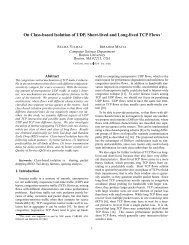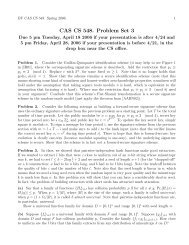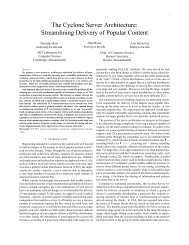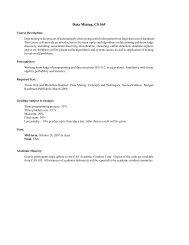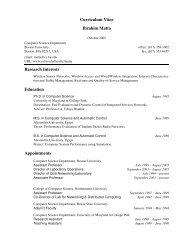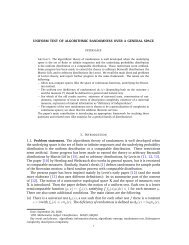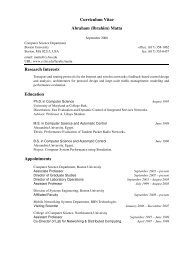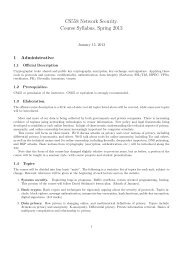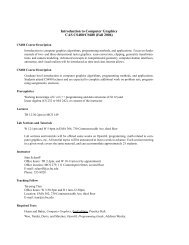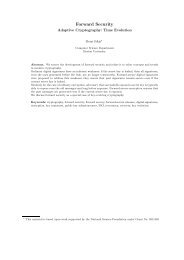Hashing Methods for Temporal Data - Computer Science - Boston ...
Hashing Methods for Temporal Data - Computer Science - Boston ...
Hashing Methods for Temporal Data - Computer Science - Boston ...
Create successful ePaper yourself
Turn your PDF publications into a flip-book with our unique Google optimized e-Paper software.
KOLLIOS AND TSOTRAS: HASHING METHODS FOR TEMPORAL DATA 3<br />
variable representing the always increasing current time. If<br />
this object is later deleted,its end_time is updated to the<br />
object's deletion time. Since an object can be added and<br />
deleted many times,records with the same oid may exist,<br />
but with nonintersecting lifespan intervals.<br />
The per<strong>for</strong>mance of a temporal access method is<br />
characterized by three costs: space,query time,and update<br />
time. Update time is the time needed to update the index<br />
<strong>for</strong> a change that happened on set S. Clearly,an index that<br />
solves the range-snapshot query can also solve the puresnapshot<br />
query. However,as indicated in [35],a method<br />
designed to address primarily the pure-snapshot query<br />
does not order incoming changes according to oid and can<br />
thus enjoy faster update time than a method designed <strong>for</strong><br />
the range-snapshot query. Indeed,the Snapshot Index [37]<br />
solves the pure-snapshot query in O…log B …n=B†‡a=B† I/Os,<br />
using O…n=B† space and only O…1† update time per change<br />
in the expected amortized sense [6] because a hashing<br />
scheme is employed). Here, a corresponds to the number of<br />
alive objects in S…t†. This is the I/O-optimal solution <strong>for</strong> the<br />
pure snapshot query [34].<br />
For the range-snapshot query three efficient methods<br />
exist: the TSB tree [24],the MVBT [2],and the MVAS<br />
structure [39]. Both the MVBT and MVAS solve the rangesnapshot<br />
query in O…log B …n=B†‡a=B† I/Os,using<br />
O…n=B† space and O…log B …m=B†† update per change in<br />
the amortized sense [6]). Here, m denotes the number of<br />
ªaliveº objects when an update takes place and a denotes<br />
the number of objects from S…t† with oids in the query<br />
specified range. This is the I/O-optimal solution <strong>for</strong> the<br />
range-snapshot query. The MVAS structure improves the<br />
merge/split policies of the MVBT,thus resulting in a<br />
smaller constant in the space bound. The TSB tree is another<br />
efficient solution to the range-snapshot query. In practice,it<br />
is more space efficient than the MVBT and MVAS),but it<br />
can guarantee worst-case query per<strong>for</strong>mance only when the<br />
set evolution is described by additions of new objects or<br />
updates on existing objects [30],[34].<br />
To the best of our knowledge,the temporal membership<br />
query is a novel problem [34]. One could,of course,use a<br />
temporal access method designed <strong>for</strong> range-snapshot<br />
queries [24],[2],[39] and limit the query range to a single<br />
oid. There are,however,two disadvantages with this<br />
approach. First,since the range-snapshot access method<br />
orders objects by oid,a logarithmic update …O…log B …m=B†††<br />
is needed. Second,because the range-snapshot method<br />
answers the membership query by traversing a tree path,<br />
the same logarithmic overhead …O…log B …m=B††† appears in<br />
the query time. Nevertheless,in our experiments,we<br />
include a range-snapshot method <strong>for</strong> completeness. Since<br />
we assume that object deletions are frequent,we use the<br />
MVBT instead of the TSB. We use the MVBT instead of the<br />
MVAS since the MVBT disk-based code was readily<br />
available to the authors. As explained in the per<strong>for</strong>mance<br />
analysis section,the MVBT was also compared with a mainmemory-based<br />
simulation of the MVAS,but there was no<br />
drastic per<strong>for</strong>mance difference among the two methods <strong>for</strong><br />
the temporal membership query.<br />
2.1 The Snapshot Index and Linear <strong>Hashing</strong><br />
The Snapshot Index [37] uses three basic structures: A<br />
balanced tree time-tree) that indexes data pages by time,a<br />
pointer structure access-<strong>for</strong>est) among the data pages,and<br />
an ephemeral hashing scheme. The time-tree and the access<strong>for</strong>est<br />
enable fast query response,while the hashing scheme<br />
is used <strong>for</strong> fast update. When an object is added in set S,its<br />
record is stored sequentially in a data page. When an object<br />
is deleted from S,its record is located and its end_time is<br />
updated. The main advantage in the Snapshot Index,is that<br />
it clusters alive objects together. To achieve this,the method<br />
uses the notion of page usefulness; a page is called useful as<br />
long as it contains uB alive records …0





